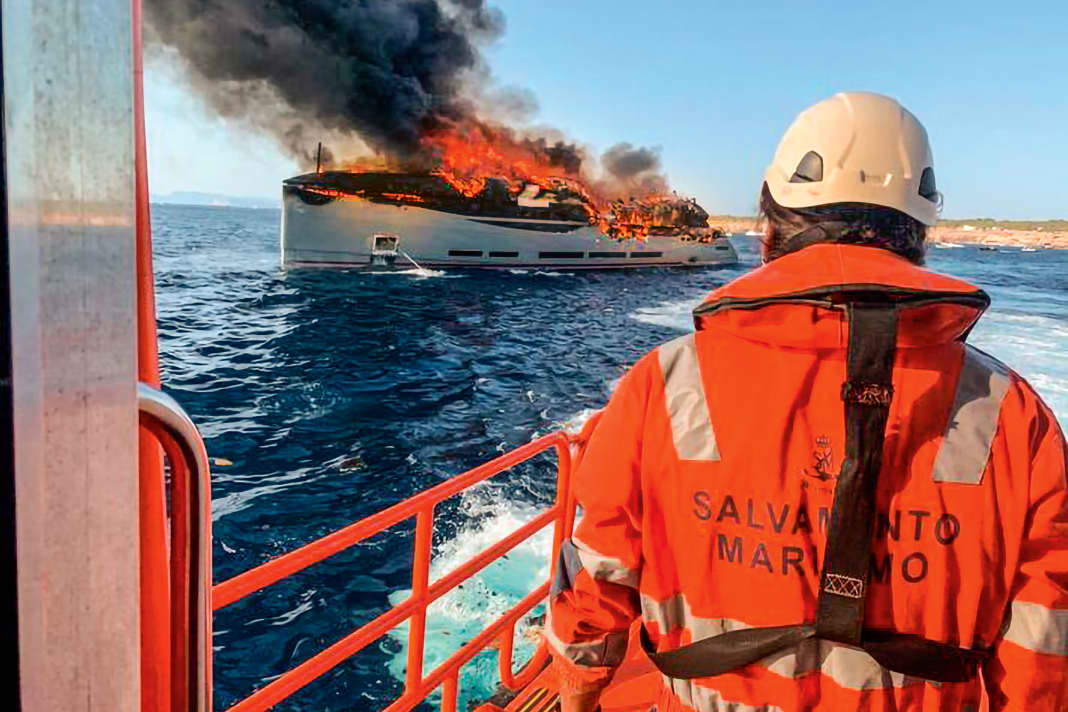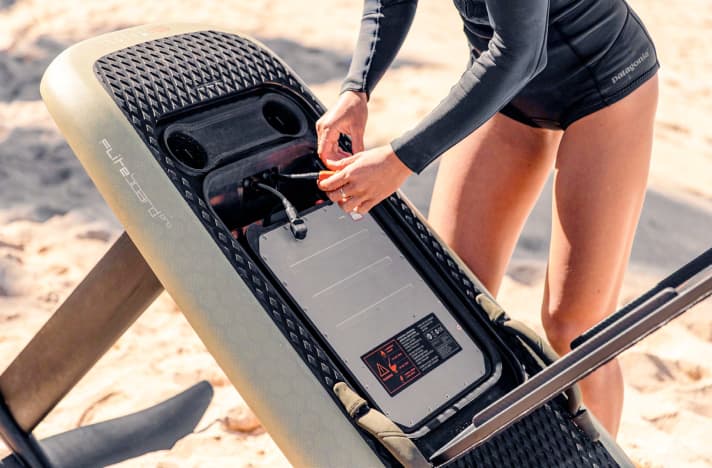Causes and prevention: Flames at sea - when the yacht catches fire






First smoke rose, then a deafening alarm signal sounded, causing all living things to startle and flee to the outer decks. The cockpit was the emergency meeting point, where guests and crew members gathered, two of whom hastily donned their red and yellow protective suits. After a quick briefing, the first engineer dived into the engine room with breathing apparatus and a hand-held fire extinguisher and neutralised the source of the fire: a PTO had overheated and was causing the smoke. Our colleagues from BOOTE EXCLUSIV experienced this situation immediately after arriving at a new 36-metre boatyard not far from Port d'Antratx. The incident demonstrated how quickly an emergency can occur - seemingly more frequently than usual last year. Fires on board are as old as shipping itself. The big question that 2022 raised, with an alarming number of images of burning yachts in all parts of the world: are fires on superyachts really becoming more frequent?
Captain Kelly Gordon points out: "Without knowing historical data on fires on board, I would say that there are actually fewer fires on board than before due to advances in technology and design. However, we are capturing more live events with our mobile devices." The US-American is qualified to skipper yachts up to 500 gross tonnes and is currently in command of the Sanlorenzo SL106 "Freddy". The 32 metre yacht is operated in Florida and the Bahamas and is also available for charter.
Training needs to be made a priority and owners need to give crews the time to do it" - (Kelly Gordon, Captain)
Gordon himself has already experienced a fire at sea. The cause was design-related: the built-in battery charger was located in the lazarette right next to a ventilation slot that could not be closed. Kelly Gordon, who was a chemistry professor in Indiana before her yachting career, remembers: "We got caught in a storm with high waves and salt water came through the opening onto the battery charger. A blown fuse eventually led to the fire. Fortunately, we didn't need any outside help. It only took two to three minutes to extinguish the fire - the longest we've ever experienced!"
Difficult research into causes of damage
Felix Zimmermann from yacht insurer Pantaenius provides a numerical classification of yacht fires: "Last year, there were twelve fire claims on yachts with a length of 24 metres or more. You have to put this figure into perspective: There are around 10,000 yachts of this size afloat worldwide, with lengths of 30 metres and more there are 5,500 yachts. In global terms, that's very little fire damage." However, these stand out due to their immediate visibility on internet portals such as Twitter.

In addition, yachts were used far more in 2022 as a result of the regained or newly discovered freedom at sea than at the height of the coronavirus pandemic. Not to be neglected is the fact that seas of flames on yachts - especially those of composite construction - often lead to total loss and are therefore much more expensive for owners than partial damage. An additional problem, according to Zimmermann, is that it is very difficult to determine the cause of the fire in such cases. And if it is unclear, the decision is always made in favour of the policyholder.
Stefan Zucker from the Hamburg-based surveyor and consultancy company of the same name reports similar case numbers and problems in determining the cause: "It's very difficult to find out. We only send surveyors with special fire expertise to yachts that have been involved in accidents. Provided the ship has not sunk to 3000 metres."
On average, Stefan Zucker & Partner GmbH investigates two to three major fires a year. "When a ship like this burns down, it's not easy to find the cause. I am not aware of any case in which it was possible to find out why the fire broke out on board," interjects Stefan Zucker.
Li-ion batteries from toys as a source of danger
The increase in the number of cases would be consistent with the fact that more electronic components are demonstrably finding their way on board and that battery-powered toys such as Seabobs, e-bikes, e-tenders, e-foils and e-surfboards in particular are becoming increasingly popular with owners and charterers.
Their lithium-ion batteries are mentioned by crews and industry experts - behind closed doors - as the biggest culprit. However, as Philip Demler from VMG Marine in Kiel-Altenholz knows, batteries should not be seen as a source of danger per se: "There are major differences in quality and safety, which is usually neglected in the current debate. It's not enough to just compare the capacity of the batteries." Demler sells e-foilers from Flite and the Audi e-Tron models from aerofoils. What distinguishes a good battery from a bad one? "Firstly, the choice of cells. Flite uses premium 21700 cells with the lowest impedance and highest permitted current. This means that the cells heat up less than others, and all load cases during use are well below the safe limits."

The Australians at Flite also use so-called phase-changing material between the cells, which offers a major advantage for thermal management within the battery and therefore for safety. And they are using titanium instead of plastic as the outer material for the new generation of batteries. The dangers that even small batteries can pose are great. Rainer Daniel from Fisacon describes the pitfalls of a battery edge in detail. Together with partners, he has developed a TÜV-certified storage and charging box with an integrated extinguishing system for Li-ion batteries. Stefan Zucker reports that classification societies have specifications for the storage of Seabobs: "They must be stowed in the garage, charged there and have a smoke detector installed above them. But that's not far enough. The problem with the smoke alarm is that if it goes off and the deckhand rushes into the garage to get a picture of the disaster, it's already too late!"

"Flite has now delivered around 10,000 batteries and there has not yet been a single incident in which a Flite battery has caused a fire risk," says Demler, an engineer who also offers technical service for e-surfboards. The battery management system (BMS) is also important. The leading manufacturers have invested a lot of development work here and designed very safe systems, while the cheaper suppliers have resorted to ready-made, less sophisticated systems. Philip Demler would even like to see more restrictions: "The battery is usually the most expensive component of an e-toy, and also the most important in terms of safety. I could well imagine yacht insurance companies starting to introduce certain minimum standards. We would welcome that."
Prevention through regular training
Of course, fires don't just come from toy batteries. Pantaenius man Felix Zimmermann explains: "Ventilation and cooling of engine compartments is also something we keep an eye on. We think very carefully about whether to insure some brands of fast gliders in particular. If the rooms get too hot due to poor ventilation, there is a higher risk of cable fire." Stefan Zucker takes the same line: "The most common causes can be found in the engine room. The classics are leaking fuel lines, where a small spray of diesel lands on the exhaust pipes, which ignites." It is often overheated cables or cable harnesses. "We've already had fires because the exhaust pipe ran close under the engine room ceiling, which in turn wasn't insulated well enough, causing the heat in the shaft above to ignite cables."

The best antidote is prevention and regular training on board, as "Freddy" captain Kelly Gordon knows. She works closely with her engineer to prepare the crew of five for a fire and transfers her knowledge of fire extinguishing and sprinkler systems to the rest of the deck crew: "We practise at least once a month for a variety of fire scenarios. We discuss different cases and I often pass on videos and training materials to the crew.
The potential danger cannot be practised and discussed often enough!" The industry standard requires monthly fire drills on superyachts. However, Kelly Gordon knows that this is not the case on many ships. Some crews are so busy and don't value training that they don't take place as often as they should. "Other yachts are not required to train for emergency scenarios. And on some there is a large majority of freelance crew, which also makes training difficult. Drills need to be made a priority and owners need to be encouraged to give crews the time they need."
New drive technologies, new challenges
Lithium-ion batteries pose far greater challenges in terms of stowage and prevention when they form part of the drive system as battery banks. Expert Stefan Zucker and his team recently accompanied a new hybrid vehicle for the first time, which can travel whisper-quietly for up to three hours on electricity from batteries. The battery pack has a capacity of 300 kilowatt hours and takes up two cubic metres alone. "This is exciting in that we had to have it approved by the classification society. The class wanted to know exactly: Where did the batteries come from? Who was in charge of the electrical installation? This was followed by two risk assessments with the topics: What can happen and how do we respond? The result of these two risk assessments was that the battery bank must be installed in an enclosed space that can withstand the fire for a certain period of time."
Risk assessments quickly made it clear that this type of fire cannot really be extinguished. Burning electric cars, for example, are parked in containers by fire brigades, which they then flood with water. One option for yachts would be to bunker a lot of sand to smother the flames. An ambitious endeavour. "With a large fire load, firstly it burns for a very long time and secondly it burns very hot," says Stefan Zucker, explaining the difference to the batteries of electrically powered fun equipment. He also notes: "It's not really green. You need a considerable amount of battery power to cool the battery system. Even in standby mode. So you're constantly investing energy to keep the batteries intact and maintain their performance."
How to make interiors fireproof
Fire protection also relates to the interior, as Benjamin Bäker, Head of Sales and Marketing at interior fit-out company Oldenburger, explains: "It's not just in terms of wood that new certificates have to be created time and again to make it difficult for fire to spread on board. Elaborate fire alarm and sprinkler systems are also installed." The severity of the measures depends heavily on the classification. While it is easier to install what customers want on a "REG-A" yacht (Ex-LY3), the challenges on a "REG-B" yacht (Ex-PYC) are many times greater. The regulations, formerly known as the Passenger Yacht Code, apply from a minimum of 13 and up to a maximum of 36 guests. Benjamin Bäker says: "Strict rules apply here. So-called special surfaces, which have long characterised this market, must also be recertified for these yachts."

Each of the several hundred different surfaces of a single project is analysed individually, the structure is reproduced one-to-one with sample panels and presented in a fire test house. "The certificates and surface structures are shared among the interior fitters involved so that not everyone has to certify everything themselves," says Bäker, who reports that not only have the regulations become increasingly complicated in recent years, but customer requirements are also constantly increasing. "The new sustainable thinking that is rightly characterising the world today is making it more complex to process non-combustible materials. However, if the customer is prepared to make minor compromises in terms of colour and shape, there are a wide range of options available."
To ensure that the number of large yachts on fire does not increase in the future, the industry must make great efforts - especially with regard to the ongoing electrification of yachting, which ranges from electric toys to electric drives.

